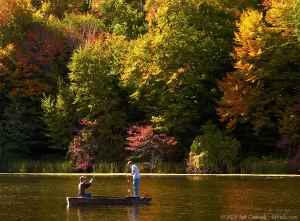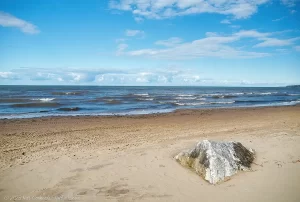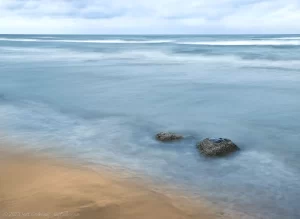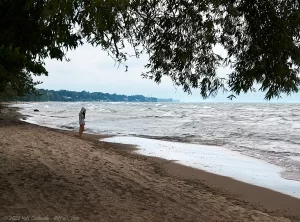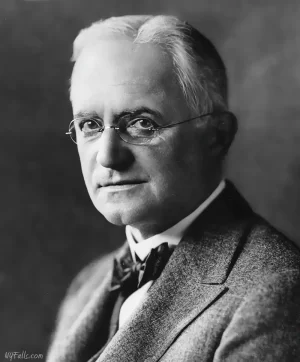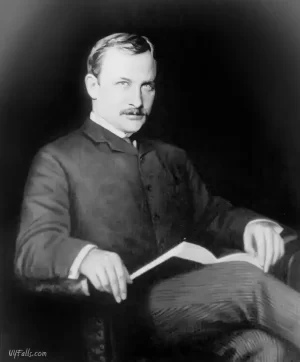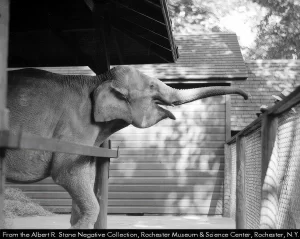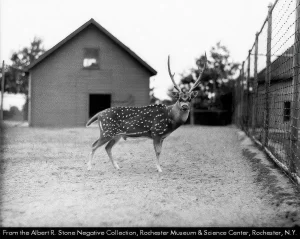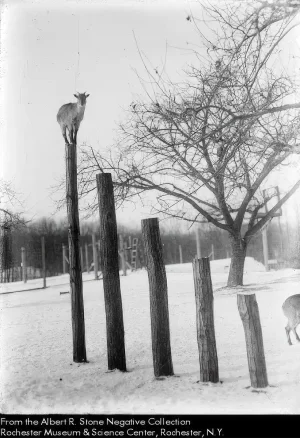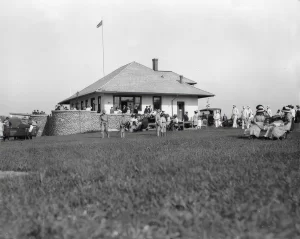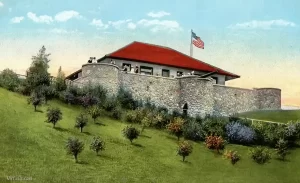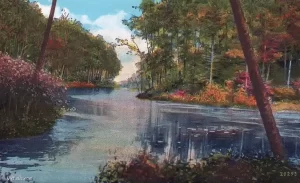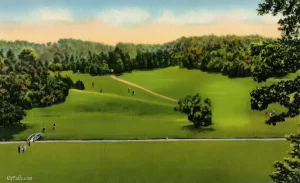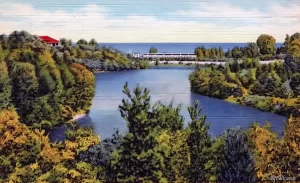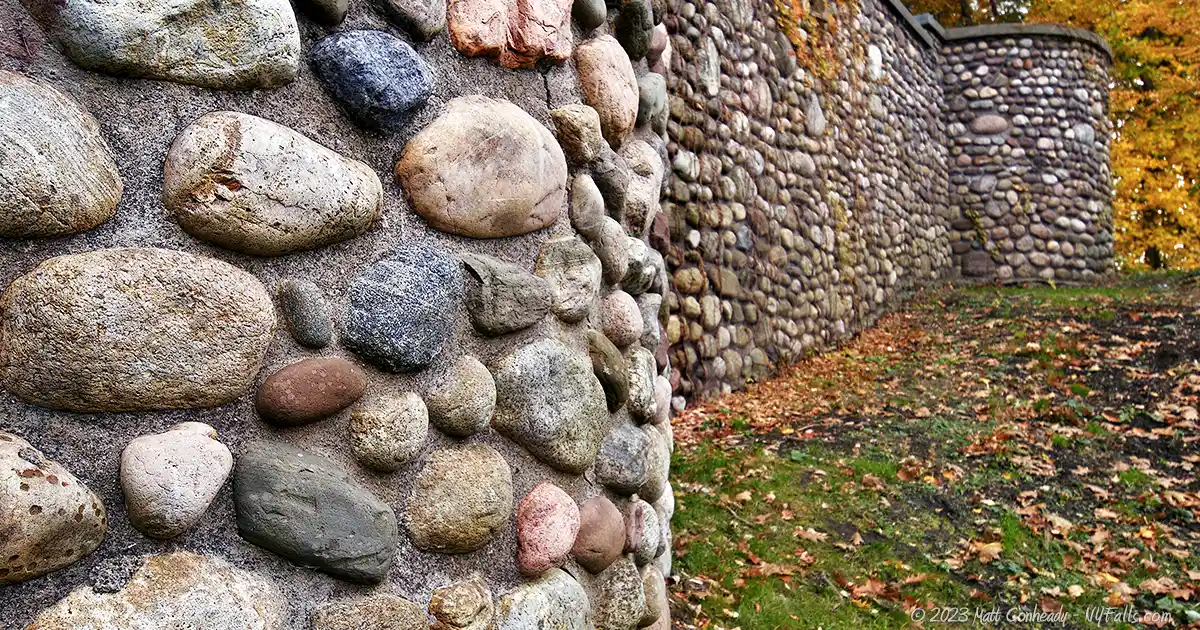Durand Eastman Park
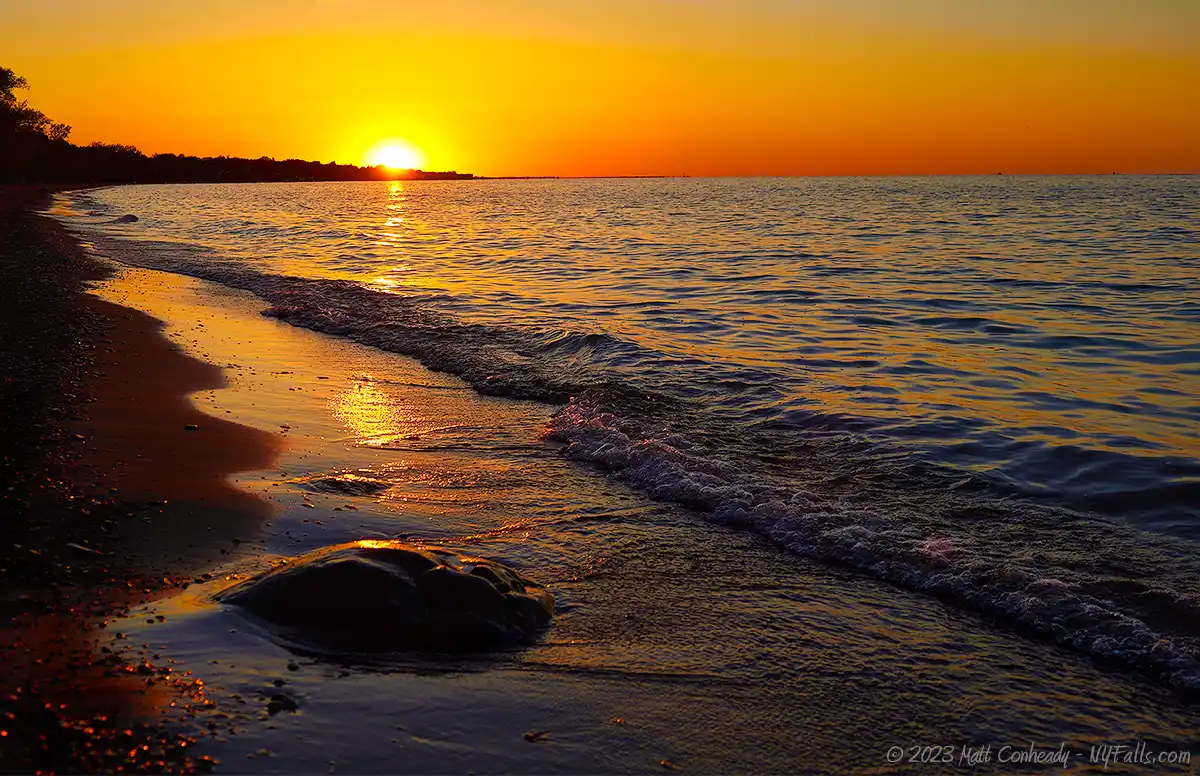
Location: On Lake Ontario; Outside of the City of Rochester; in the Town of Irondequoit; Monroe County; New York.
Maps: Google Map; Topographic; Interactive map; Park_Map; Trail_Map; Arboretum Guide
GPS Coordinates:
- 3 Lakes Pavilion/Refectory: N 43.23570 / W 77.55686
- Swimming area: N 43.24194 / W 77.57457
- Eastman Lake parking: N 43.23725 / W 77.56096
Directions: From Rochester, take I-590 North to Durand Blvd, which becomes Sweet Fern Rd after it crosses Culver Rd. Follow Sweet Fern Rd as it merges with Pine Valley Rd. It will soon run parallel with the lake and become Lake Shore Blvd. Park in any of the lots along the lake. Or use Google Maps.
Parking: Several lots can be found lakeside along Lake Shore Blvd. Additional parking can be found near the pavilions or within small lots around the park. See the interactive map below.
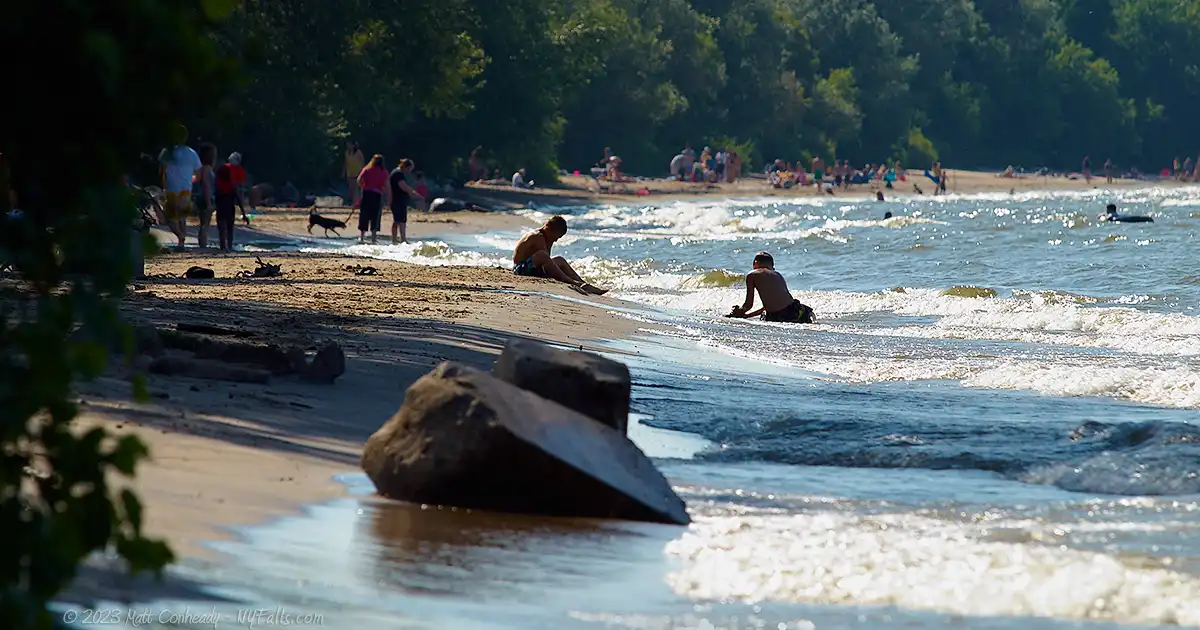
Weather
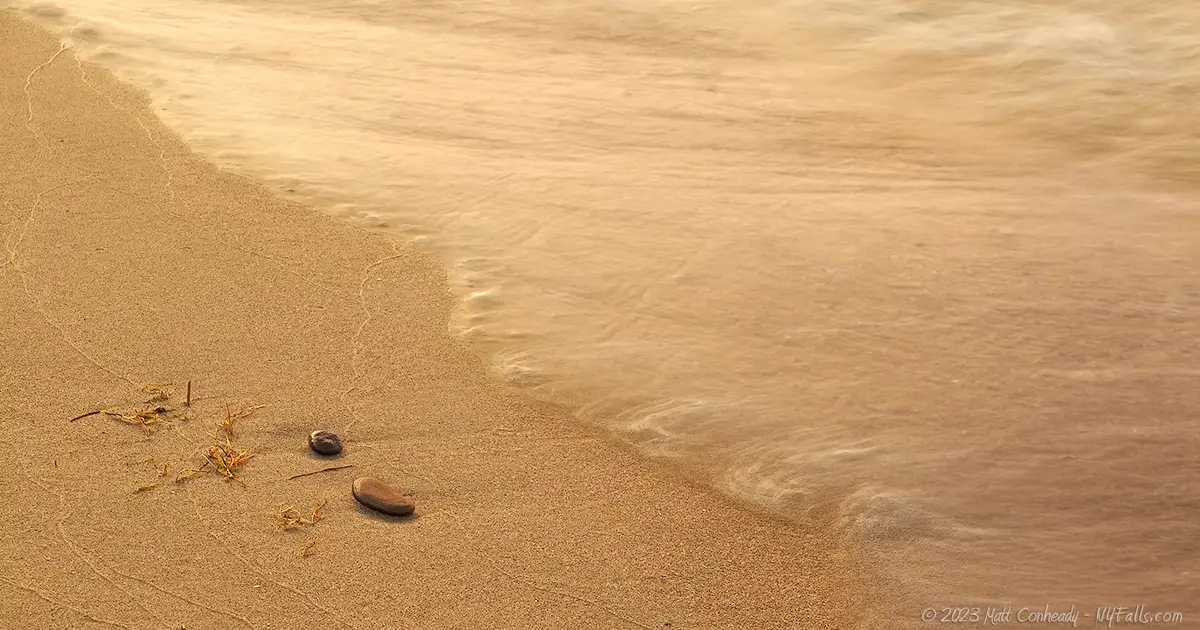
Information / Accessibility / Accommodations
Seasons/Hours: April 1st until October 31st: the park is open every day from 7:00 a.m. until 11:00 p.m. Shelters are available to rent from 10:00 a.m.
November 1st until March 31st: Monday through Thursday the park is open 7:00 a.m. until 4:00 p.m. Friday through Sunday the park is open from 7:00 am until 11:00 pm.
Admission: Free.
Best time to visit: Spring for the flowering trees; summer for the beach; fall for the foliage; winter for the cross-country skiing.
Time: From a few minutes to see Lake Ontario to a full day enjoying the beach, trails and picnicking.
Handicap accessibility: Yes, paved trails, such as the Lakeside Trail and Arboretum Trail are accessible. All permanent pavilions and restrooms are accessible.
Pets: Allowed if on a leash. For your pet’s safety, and the safety of other hikers, keep your pet on the leash! It doesn’t matter if your dog is “friendly,” it’s the law. Please clean up after. Pets are not allowed in the swimming area.
Swimming: Allowed within the designated swimming area, and only when a lifeguard is on duty. Water-quality issues will lead to beach closings. If the beach is closed, water contamination or turbidity are potential dangers to swimmers. Call the Monroe County Beach Hotline at (585) 753-5887 for information on beach closings.
General schedule: From Memorial Day through the first week of September, starting with Saturday/Sunday only, then 7 days a week beginning in July. Beach hours are from 11 am to 7 pm.
Boat launch: You can hand-launch paddle boats anywhere along the Lake Ontario beach, or at the dirt ramp on Durand Lake near Lake Shore Blvd. A trailer launch can be found at the Irondequoit Bay Marine Park off of Culver Rd.
Accommodations: Restrooms; swimming; changing rooms; hiking trails; picnic tables; grills; pavilions; 18-hole golf course; playgrounds; arboretum; fishing access; historical and informational signage.
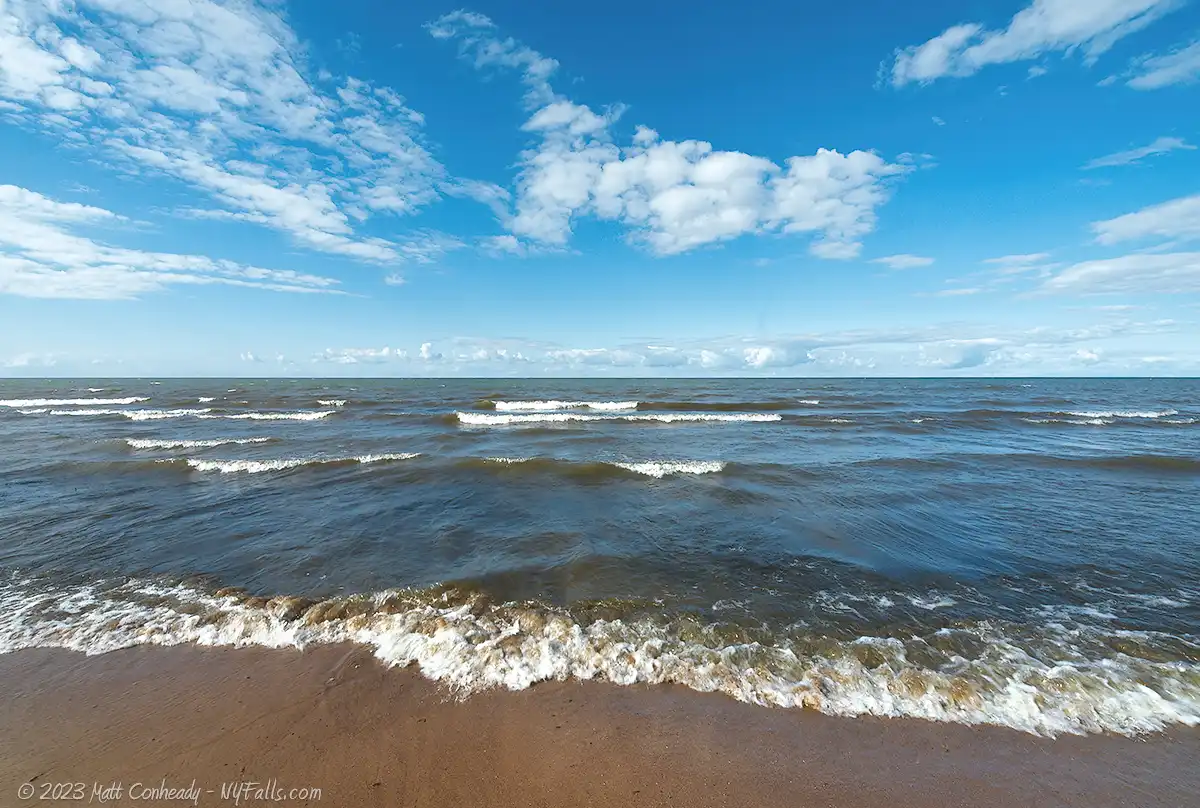
Description
With over 5,000 feet of glimmering sand along the Lake Ontario shore, amidst the backdrop of 1,000 acres of forested rolling hills, freshwater marsh, and mirror-like ponds, Durand Eastman is easily one of Rochester’s most beautiful parks. Situated in the Town of Irondequoit, west of the bay, the property, which once belonged to the City of Rochester, is now owned and managed by the Monroe County Parks Department. Despite its urban proximity, when walking within the park, much of the feeling of the surrounding development is removed and the sights, sounds and appreciation of nature take over.
The park’s main draw is its fantastic sandy beach, which is isolated from Lake Shore Blvd by a thick line of trees and is instantly accessible from the main road. Although the beach is closed frequently for water-quality reasons, when open it draws in hundreds of visitors on hot summer days for swimming, sunbathing, and various water-sports. In its heyday Durand Eastman catered to several thousand bathers along its 5,000 ft of shore, which was dotted with food vendors, bathhouses and parties. Although plagued for many years by polluted and turbid water due to inadequate waste-water processing, a recent decree by former city mayor Robert Duffy has put the re-opening of the beach to the forefront. Although it gets nowhere near the traffic it once did, it is still a gem to be appreciated for its scenic beauty and close proximity to the city.
The park is also home to Durand and Eastman Lakes (man-made ponds, actually) that are tucked in-between the wooded hills just south of the beach. The hilly terrain of Durand-Eastman, spanned almost entirely with park roads and trails, is home to hundreds of species of trees that serve to seclude visitors from the outside world. Hiking the Durand or Eastman Lake trails provides an exhilarating tour of lake-side wetland habitats, mixed-deciduous forests, and cultured parkland that the whole family can learn from and enjoy. And the dramatic scenery, coupled with the amount of wildlife one is sure to encounter, is almost unheard of for an urban park.
Recreation at Durand-Eastman doesn’t have to stop at swimming or hiking. The Durand-Eastman Golf club, boasting a Robert Trent Jones-designed 18-hole course, is the crown jewel of the county’s public golf courses. Fitting snugly into the natural ravines of the north-west section of the park, it crisscrosses small streams and winds in and around the wooded hills and lively swamps that characterize the park.
For the park’s grand opening in 1909, the Rochester City Parks Department, the same men responsible for the renowned Lilac Garden of Highland Park, led by Bernard Slavin, collected specimens from around the US and several from overseas to build this stunning collection of trees. The result is one of the region’s premier arboretums. The Durand-Eastman Arboretum, which spans a large portion of the west park, from Zoo Rd. to Culver Rd, becomes a kaleidoscope display of colored petals in spring. In autumn, the park’s colors provide an amazing palette that challenges even the latest digital camera sensors. Each trunk is labeled with the common name as well as the genus/species, helping everyone hone their dendrology skills. Although the arboretum is a nice consolidation of the many varieties, the whole park is home to numerous rare and interesting specimens, just waiting to be found.
For large gatherings, the park has plenty of pavilions available for day use. Although there are no ball fields or courts, there are a few playgrounds, and the narrow open field near the beach is perfect for volleyball or Frisbee. In winter, cross country skiing and snowshoeing are favorite activities.
History
The most recent glacial period that swept over the Rochester region occurred 100,000 years ago and drastically altered the landscape. The Genesee River once emptied into Lake Ontario at Irondequoit Bay, but the tremendous pressure of the colossal sheets of glacial ice compressed and distorted the land, moving the river to the west and leaving the former Genesee River delta to become Irondequoit Bay. The soft sandy hills of Durand Eastman Park are the result of the former river delta, deposited from sediment carried from the highlands in the south across the state to the Lake Ontario shore.
As Rochester blossomed into a thriving milling and manufacturing city, the outskirts concentrated on agriculture. The land closest to the lake, with its damp, cool air, was perfect for orchards, one of which occupied what was to become Durand Eastman Park.
The park is named for Dr. Henry Strong Durand, a prominent Rochester surgeon, inventor, and poet, and his casual acquaintance, George Eastman, inventor and founder of the Eastman Kodak Company. Henry Durand’s youngest sister, Mary, wed George Eastman’s personal physician, which through a simple twist of fate, connected the two friends. Inspired by Eastman’s acquisition of properties around Rochester, Durand himself took interest in a slice of lakeside real estate, which is now a part of the arboretum near Zoo Rd. Enamored by the beauty of the land, Durand retired from medicine in 1898 and built a beautiful home there in 1904. Although Durand made several enhancements to the property, such as a servants’ cabin, ice-house, garage and fruit cellar, he cherished the wild feel, isolation and serenity it offered and left much of the landscape alone.
Eastman (who had purchased the adjacent property) and Durand recognized the popularity of Ontario Beach across the river in Charlotte and other private camps and lakeside resorts, and saw the need for a public beach for the City of Rochester. They agreed to jointly donate their combined 484 acres to the city of Rochester for permanent use as a public park. Durand, who expected the city to grow the park with new acquisitions, also stipulated that his buildings, including his Victorian home, be leased responsibly, and that the revenue made be used to maintain his estate. The properties were granted to the city in 1908.
Lured by the buzz of gold out west, Durand left for Urique, Mexico on a mining expedition, where he wound up helping local villagers as their only doctor and became a local hero. Eastman assured Durand that while he was away, Eastman would make sure that he would be remembered for such a great contribution, and thus the park was named “Durand Eastman.” With Durand away, the City of Rochester began heavy development on the park, constructing roads (including Lake Shore Blvd), parking lots, a gazebo, tearing down Durand’s fences, garage and servant quarters, and removing the orchard to make way for a zoo and game preserve. With Eastman tied up with other affairs and Durand in remote Mexico during a war (and presumed dead) neither could be consulted about these “improvements.”
Durand Eastman Park opened on May 22, 1909 to much fanfare. As the city’s only public beach, and a free one at that, thousands of visitors flocked to the Irondequoit lakefront. The zoo and game preserve were opened in a fenced off ravine, picnic pavilions were built, and a large refectory (dining hall) was constructed on a bluff overlooking Lake Ontario. At the time, the beach tract was much wider than it is today, and in 1916 a large public bathhouse was built on it to accommodate up to the 2,000 bathers that visited each day. Massive towers shone spotlights on the water to allow for night bathing. In 1917, a 9-hole golf course with views of the lake was added.
Durand returned from Mexico in 1915 to find many of his buildings torn down, his apple orchard removed, and a zoo built in a once beautiful wooded ravine. Outraged, he complained to the city, which assured him the zoo was only temporary. Fed up with the development of his property, he closed up his house, sold his equipment, and moved his family to California. He returned again in 1920 after receiving word that the city passed up the chance to add an adjacent property to the park, and found the zoo was still there. In 1922 he returned yet again, and after seeing his former property in even more disarray, he sent a bill to the mayor of Rochester for “unwarranted and unlawful seizure of my land for the purpose of a zoo.” Shortly after, he relocated to Paris. From there he continued to correspond with George Eastman, who fed him news of the success and importance of the park, and suggested he forgive the city for what was done. In 1923, they agreed to finish two artificial lakes by damming small steams in two major ravines on the west side of the park. The lakes were named for each of them. Durand died in Paris on May 29, 1929 and his ashes rest at Rochester’s Mount Hope Cemetery. Eastman died on March 14, 1932 in Rochester. His ashes are buried at Kodak Park.
Popularity of the park remained steady as the city developed it more and more. Camping facilities were added in 1925 and the golf course was expanded to 18 holes in 1931. Unfortunately, rising lake levels forced the closure of the beach and the demolition of the grand bathhouse in 1948. The beach remained closed until 1958 when the Moses-Saunders Power Dam was built on the St Lawrence River, which allowed for better regulation of the lake’s levels. Although this brought back swimming to the park, the beach has never returned to its former size. Bathers continued to enjoy the lake until 1966 when overwhelming pollution forced its closure again, this time until 2006. In 1969, Monroe County acquired the park and began management under their parks department. A water treatment plant was built onsite to help manage sewage overflow and subsequent upgrades to the facility made significant improvements, but none enough to ensure a consistently open beach. To this day, although the park is officially open to swimmers in the summer, it is monitored daily for contaminants and clarity and the beach is closed often.
Hiking / Walking Trails
Difficulty: Easy to moderate.
Distance: There are over 5 miles of trails in this park, many of which are roadside walks. No trail is over 2 miles but multiple trails can be combined for a longer loop.
Markings: No official markings, but some trails are paved.
Description: The trails at Durand are extensive and varied. We won’t go into much detail for each trail here, but rather provide brief summaries of the main trails featured in the park. There is an interactive map below.
Lake Trail – 1.2 miles – This paved multi-use trail is sandwiched between the parking lots and the sandy beach of Lake Ontario. The relatively flat land makes this an easy walk along the shore, and many outcroppings in the trees contain paths leading to the beach. Some park information signage is available along the way.
Sunset Trail – 0.5 miles – This is a slightly hilly walk along the shaded Sunset Point Road, which is closed to traffic. Starts and ends at Lake Shore Blvd.
Eastman Lake Trail – 1.5 miles – This nature trail is not in the best of shape due to erosion of the sandy hills, but it is easily the most exhilarating. It is best started from Log Cabin Rd, where the trail cuts into the woods and gets increasingly closer to Eastman lake. Basking turtles and croaking frogs are a common sight and you will get used to them quickly dashing underwater as you approach. At the southern end, the lake turns into a cattail marsh. The sense of isolation from the busy Lakeshore Blvd at this point is at a maximum. Spotting waterfowl and songbirds is easy at this end; just a little patience is needed. The south switchback cuts through the park’s golf course; watch for flying balls. The eastern end of the trail runs right along the shoreline, and offers fishing access as well as some precious views of the lake landscape. This trail is a must-hike in the colorful fall season.
Durand Lake Trail – 1.2 miles – Like the Eastman Lake Trail, this hilly, wooded nature trail wraps around the Durand Lake, starting from the Refectory wall off of Lakeshore Blvd. The eastern flank hugs close to the shore putting you close to the lake and often in the mud. This is also an excellent spot to fish from. At the southern end, the trail intersects with the Trott Lake Trail. Heading back north pulls you a bit away from the lake and more into the wooded hillside. A great spot to stop and enjoy the scenery is from one of the two outcrops of land that jut out into the lake. The cove in-between them seems to be a hotspot for mallards.
Trott Lake Trail – 0.75 miles – This less-traveled trail around small Trott Lake connects with the Durand Lake Trail to the north and the Arboretum trail to the east. Part of it crosses the magnolia grove.
Arboretum Trail – 1.3 miles – This roadside trail loops around the majority of the park’s Arboretum. It is slightly hilly and completely paved. Zoo Road is open to traffic but not frequented by many cars. The southern half of Pine Valley Rd is closed to traffic, but caution must be used when hiking alongside the northern section of Pine Valley Rd as traffic can get a bit crazy. Zoo Road takes you by a fantastic collection of magnolias as well as columnar trees, rare species of pine, and flowering trees. Pine Valley Rd has a nice rhododendron collection on the southern end, leads through a fantastic pine collection (Pine Valley) and along Tamarack Swamp. This trail is a must for spring and it is recommended you head off trail to see what rare species are hiding off in the distance. This trail is also excellent for cyclists and wheelchairs (looking for a slight challenge).
Tamarack Swamp (Leastman) Trail – 1 mile – A relatively new addition to the park’s trail system, this trail runs from the east end of the Lakeside Trail to the very east entrance to the park on Culver Road. A winding boardwalk takes hikers and cyclists across Tamarack Swamp, a beautiful cattail marsh that glistens bright green in the spring and turns a rich gold in the fall. The trail then winds around the sandy hills on the east side of the swamp before leveling out and running parallel to Sweet Fern Rd to the park entrance. This trail is best combined with the Lakeside trail for a calm, but scenically varied, 2.2 mile hike.
Maps: See the interactive map below for trails; Durand Eastman Park Trail Map
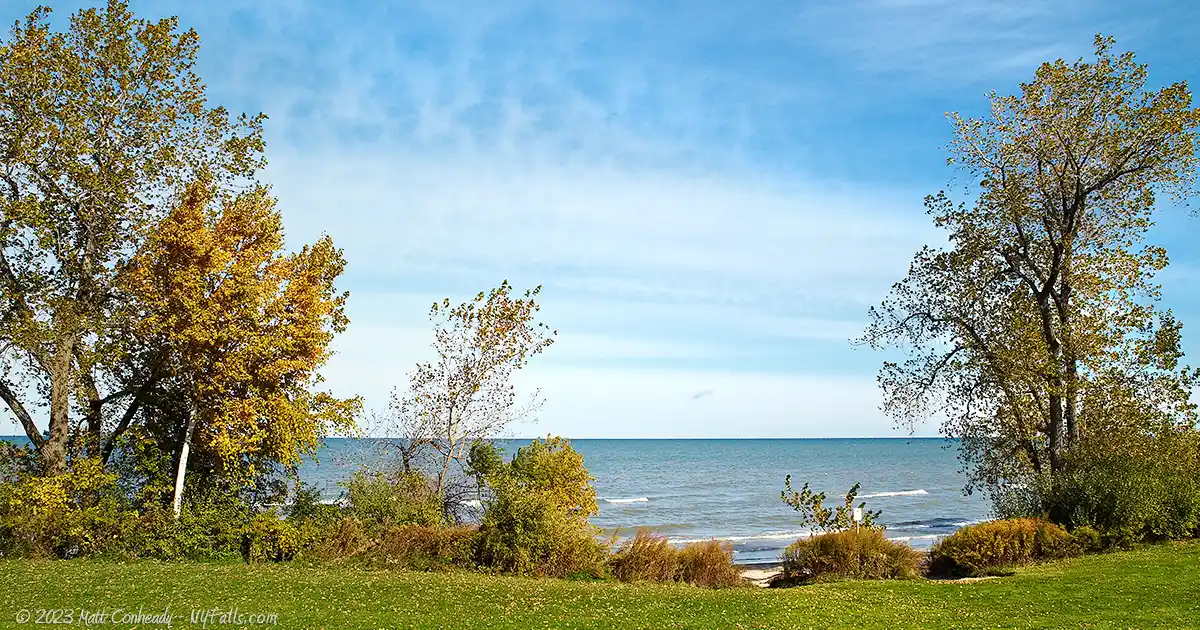
Durand Eastman Park Interactive Map
Fishing
Fishing is allowed at the park in either Lake Ontario or the ponds. There are no piers or platforms for fishing. Shoreline casting or by boat.
Interesting Stuff
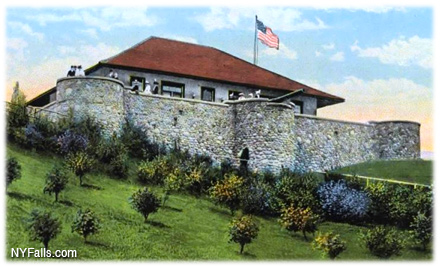
Three Lakes Pavilion (the Refectory)
Although often referred to as the “Lady in White’s Castle,” in association with that legend, the unusual cobblestone wall that emerges from the hillside at the 3 Lakes Pavilion (in-between Durand, Eastman and Lake Ontario) is not the remnants of a house or castle, and never was resided in by the “Lady in White.” It is what is left of the Durand Eastman Refectory, a dining hall built around 1916-1918. Designed in the style of a Spanish pioneer fort, it served as a relaxing place for communal dining, away from the busy beaches when the park saw thousands of visitors a day. The dining hall sat above the wall on the level field behind it and an iron cannon pointed out towards Lake Ontario from the center battlement.
The Lady in White
 Local legend has it that the park grounds are haunted by the “White Lady,” the ghost of a woman who once lived in The 3 Lakes Pavilion’s castle-like walls, which is often described in the story to be the remains of the “White Lady’s Castle,” is in fact what is left of the park’s refectory (or dining hall) that ran throughout the 1920s when the park saw upwards of a thousand visitors a day. It was shut down during the Great Depression, and left to decay into the 70s. The condemned structure’s mystique, overgrown and boarded up, combined with the lack of published historical information about it, contributed greatly to the legend. There are many variations on the tale, but the most common consensus is that she lost her daughter (either kidnapping, suicide, murder, accident or runaway) and even in death, the White Lady continues to search the park for her missing daughter and/or the people responsible for her disappearance. Most tales depict the lady as dressed all in white, with a faint glow, emerging from either Durand or Eastman lake at nightfall. Lesser-known variations even have her graceful form accompanied by ferocious demonic hounds. The 1998 horror-mystery, The Lady in White, was written and directed by Rochester native Frank LaLoggia, and based on this legend.
Local legend has it that the park grounds are haunted by the “White Lady,” the ghost of a woman who once lived in The 3 Lakes Pavilion’s castle-like walls, which is often described in the story to be the remains of the “White Lady’s Castle,” is in fact what is left of the park’s refectory (or dining hall) that ran throughout the 1920s when the park saw upwards of a thousand visitors a day. It was shut down during the Great Depression, and left to decay into the 70s. The condemned structure’s mystique, overgrown and boarded up, combined with the lack of published historical information about it, contributed greatly to the legend. There are many variations on the tale, but the most common consensus is that she lost her daughter (either kidnapping, suicide, murder, accident or runaway) and even in death, the White Lady continues to search the park for her missing daughter and/or the people responsible for her disappearance. Most tales depict the lady as dressed all in white, with a faint glow, emerging from either Durand or Eastman lake at nightfall. Lesser-known variations even have her graceful form accompanied by ferocious demonic hounds. The 1998 horror-mystery, The Lady in White, was written and directed by Rochester native Frank LaLoggia, and based on this legend.
Many cultures, and strangely many American suburban neighborhoods, have their own variations of “White Lady” legends, usually involving a mysterious ghost who appears at night wandering in search of someone or something. It may be the dramatic environment Durand Eastman Park offers, the existence of supposed physical evidence, and the appearance of the legend in several forms of media, that makes it one of the more prolific of such tales.
Photography Tips
Fall color
- Durand and Eastman Lakes are prime locations for fall foliage in the Rochester region. Come here on days of low wind for mirror-like conditions to get crisp, sparkling reflections in the water.
Clouds
- Dramatic skies make for more interesting lake landscapes.
Beach Scene
- Don’t limit yourself to landscapes and wildlife, beach activities, races and parties make for great captures too.
Birds
- Hike the Durand and Eastman Lakes Trails before sunrise to get glimpses of species that don’t stick around for the tourists.
Basking
- As the day begins to heat up, turtles and frogs will climb on top of logs or along the pond shore to warm up their bodies for the day. Sneak up on them early in the morning with a telephoto lens to get some great captures.
More tips
- See the Articles and Message Board sections for more photography tips.

Nearby Waterfalls
More Lake Ontario Parks & Beaches
Find a new summer hangout spot or place to swim in our comprehensive guide to Lake Ontario Parks and Beaches in New York State.
Who to Contact
(for shelter reservations and information):
Monroe County Department of Parks
171 Reservoir Ave.
Rochester, NY 14620 Phone: (585) 753-7275 for general park information and reservations.
(585) 753-5887 for beach closings.
(585) 428-7888 for general beach information, swimming lessons and policy.E-mail: [email protected]
Web: monroecounty.gov/parks-index.php





